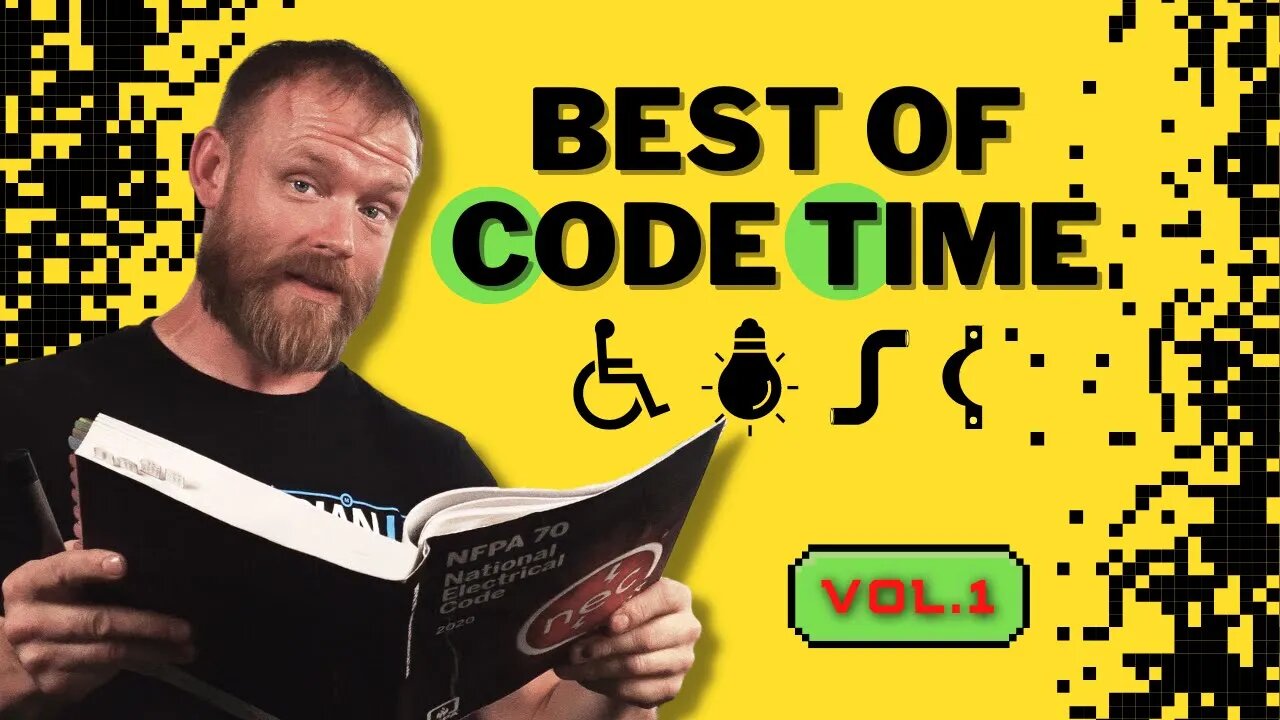Premium Only Content

BEST OF CODE TIME: ADA Requirements, Luminaires in Closets, Rigid Conduit Bends and EMT Securing
When it comes to the installation of our electrical work, we are not allowed to just put things in how we see fit! We must adhere to at least the minimums and maximums of the current NEC. In the latest episode of Electrician U, Dustin discusses some of the ADA requirements, luminaires in clothes closets, GRC bending and EMT securing.
🤘⚡️MEMBERSHIP⚡️🤘
JOIN ELECTRICIAN U - become a member and get:
FREE Continuing Education every year
FREE Practice Exams
FREE Monthly Video Courses
FREE Weekly Live Instructor-Led Classes
FREE Monthly Educational Newsletter
Premium Members-Only Content
Private Discord Channel
Monthly Members-Only Discord Chats
Sign up here --- https://www.electricianu.com/electrician-u-membership/
🎧🎹MUSIC AND VIDEO:🎹🎧
https://www.facebook.com/descantmv
🎬✍️ART AND ILLUSTRATION:✍️🎬
https://www.daverussoart.com
Annex J of the NEC discusses ADA standards for accessible design. This means that we are to install our electrical work that will accommodate those who have certain needs. For most of us, reaching a receptacle installed at 15” off the ground would generally not be an issue. But for a person who is in a wheelchair, having to reach down that far to plug something in may not be that easy. The same can be said for higher items like switches; having to reach above 48” may pose a problem for someone in a wheelchair. So, per the ADA standards, receptacles are generally mounted at 18” (as the minimum is 15”) and switches at 48” to the top of the box (48” switch height being maximum) to allow wheelchair bound individuals to access those items.
Clothes closets typically have a light fixture in them so someone can see what it inside! However, we cannot put a fixture just anywhere we want within the closet. Light fixtures tend to get warm (even hot) when they are on for any length of time, and since most types of clothes can catch fire, we need to be mindful of where we place the fixtures in a closet. Article 410.16 of the NEC discusses luminaires in clothes closets. This article tells us what types of fixtures we are allowed to install in a closet and where we can put them. For instance, we can use surface or recessed incandescent or luminaires with completely enclosed light sources, but we cannot install incandescent luminaires with open or partially enclosed lamps or pendant luminaires. It is just too easy for those types to come into contact with clothes and would pose a fire risk if installed. Article 410.16C also gives us locations where we are allowed to place a fixture within a closet dependent upon the type of light fixture being used. For instance, a surface mounted completely enclosed LED or incandescent fixture must be placed 12” from the clothes storage space while a recessed completely enclosed LED or incandescent can be 6” from the clothes storage space.
Article 344 of the NEC governs the installation of Rigid Metal Conduit. As with other types of rigid conduit, we are allowed a maximum amount of bend in a run before we need to set a box or other type of pull point, that number being 360 degrees. A common mistake made by newer electricians is to say we are allowed 4 90-degree bends. While 4 90-degree bends DOES add up to 360 degrees, we still need to account for any other bends within the conduit run such as offsets! So, you could have 4 90-degree bends, but there cannot be any other bends in the run.
Article 358 of the NEC discusses EMT and its usage and article 358.30 is where we would find the strapping/supporting requirements. In essence, for EMT, we are required to strap our conduit within 3’ of every outlet box, junction box, device box, cabinet, conduit bodies (LB for example), or other tubing termination and then at intervals not to exceed 10’. We are certainly allowed to install our strapping closer together, but not further apart than that. Keep in mind that the NEC is MINIMUMS and MAXIMUMS. We can always go above and beyond what the NEC directs us to, just not less than.
We hope this has been helpful in explaining a few of the many code and informational sections within the current 2020 NEC Code Book. Is there a topic you would like to see discussed in a video? Leave a comment in the section below and let us know! Please continue to follow Dustin and Electrician U as we are constantly adding to our content to assist our followers become the best that they can be!
-
 0:56
0:56
Electrician U
2 years ago90° Drill Attachment!!! - What Hand Tools Are YOU Missing
5.78K1 -
 LIVE
LIVE
The Charlie Kirk Show
53 minutes agoMark Kelly Court Martial + AI Embargo + Thanksgiving | Davis, Federer, Newcombe | 11.25.2025
3,000 watching -
 53:20
53:20
The Rubin Report
2 hours agoLara Trump Destroys Bill Maher’s Narrative w/ Facts in 1 Minute
13.8K20 -
 LIVE
LIVE
LFA TV
14 hours agoLIVE & BREAKING NEWS! | TUESDAY 11/25/25
3,866 watching -
 1:08:44
1:08:44
VINCE
4 hours agoThe Deep State Strikes Back! (Guest Host Shawn Farash) | Episode 176 - 11/25/25 VINCE
179K106 -
 DVR
DVR
Benny Johnson
3 hours agoIt's All True, The 2024 Election Was Ready To Be Rigged. The REAL Story of How Trump-Elon STOPPED It
46.3K51 -
 LIVE
LIVE
The Mel K Show
1 hour agoMORNINGS WITH MEL K - A Republic.. If You Can Keep It! 11-25-25
860 watching -
 LIVE
LIVE
The Shannon Joy Show
2 hours agoDOGE Is DEAD * Trump’s Golden Economy Implodes * LIVE Exclusive With Galileyo CEO Brett Miller
188 watching -
 LIVE
LIVE
Grant Stinchfield
19 hours agoFree Speech DEAD in Britain: Islamic Migrant Chaos Sparks Police Crackdown on the Law Abiding!
128 watching -
 LIVE
LIVE
Daniel Davis Deep Dive
3 hours agoCol Doug Macgregor: Ukraine Russia Peace Proposal Moscow Awaits Official Version
157 watching